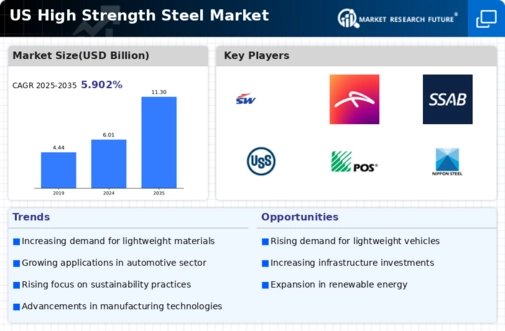The high strength steel market is characterized by a competitive landscape that is increasingly shaped by innovation, sustainability, and strategic partnerships. Key players such as Nucor Corporation (US), United States Steel Corporation (US), and Steel Dynamics, Inc. (US) are actively pursuing strategies that emphasize technological advancements and operational efficiencies. Nucor Corporation (US) has positioned itself as a leader in sustainable steel production, focusing on recycling and reducing carbon emissions, which aligns with the growing demand for environmentally friendly materials. Meanwhile, United States Steel Corporation (US) has been enhancing its digital transformation initiatives, aiming to optimize production processes and improve supply chain management. Steel Dynamics, Inc. (US) is also investing in expanding its manufacturing capabilities, particularly in high strength steel products, to meet the evolving needs of the automotive and construction sectors.
The business tactics employed by these companies reflect a concerted effort to localize manufacturing and optimize supply chains. The market structure appears moderately fragmented, with several players vying for market share while also collaborating on various initiatives. This competitive environment is influenced by the collective actions of these key players, who are not only competing on price but also on innovation and sustainability.
In November 2025, Nucor Corporation (US) announced a partnership with a leading technology firm to develop advanced steel production techniques that reduce energy consumption by 30%. This strategic move is significant as it underscores Nucor's commitment to sustainability while enhancing its competitive edge in the high strength steel market. The collaboration is expected to yield substantial cost savings and position Nucor as a pioneer in eco-friendly steel production.
In October 2025, United States Steel Corporation (US) launched a new digital platform aimed at streamlining its supply chain operations. This initiative is crucial as it allows for real-time tracking of materials and inventory, thereby improving operational efficiency. The digital transformation is likely to enhance customer satisfaction by ensuring timely deliveries and reducing lead times, which are critical factors in the competitive landscape.
In September 2025, Steel Dynamics, Inc. (US) expanded its production capacity by investing $200 million in a new facility dedicated to high strength steel manufacturing. This expansion is indicative of the company's strategy to capitalize on the growing demand from the automotive sector, which increasingly requires lightweight yet strong materials. The investment not only enhances Steel Dynamics' market position but also reflects a broader trend towards increased production capabilities in response to market demands.
As of December 2025, the competitive trends in the high strength steel market are increasingly defined by digitalization, sustainability, and the integration of artificial intelligence. Strategic alliances are becoming more prevalent, as companies recognize the need to collaborate to enhance their technological capabilities and market reach. Looking ahead, competitive differentiation is likely to evolve from traditional price-based competition to a focus on innovation, technology, and supply chain reliability. This shift suggests that companies that prioritize these aspects will be better positioned to thrive in an increasingly complex market.





















Leave a Comment